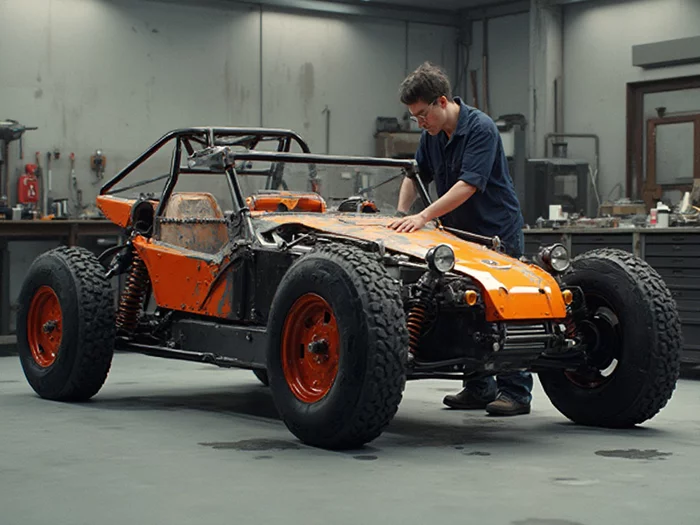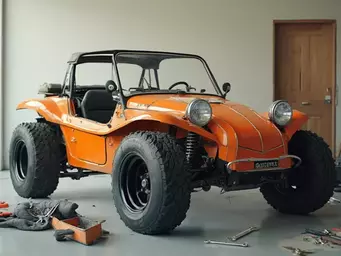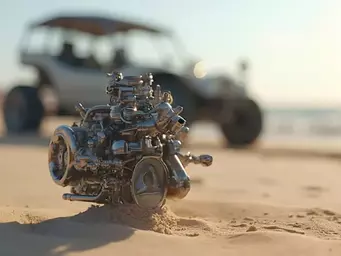1. Damage Identification
- Visible rust (chassis, panels)
- Cracks/gaps (fiberglass body)
- Unusual noises (squeaks, rattles)
- Alignment issues (panels, doors)
Get the latest beach buggy build guides, restoration tips, and performance upgrades delivered directly to you.
Posted on: 2025-10-14
By: Jasper Quinn
Taking care of your beach buggy is not just an option; it's a necessity for both performance and safety. Regular inspections and awareness of potential damage can save you time and money, ensuring your adventures remain thrilling rather than troublesome.
This visual outlines the key steps for identifying damage, diagnosing issues, and maintaining your beach buggy to prevent future problems.
As a beach buggy enthusiast, I’ve seen my fair share of body and chassis damage over the years. Identifying these issues early can save you time and money down the road. Typical problems include rust, cracks, or even structural weaknesses that can arise from both environmental factors and usage patterns. Paying close attention to your buggy’s condition helps maintain performance and safety.
Some common signs of damage include visible rust spots, dents from rough terrain, or misaligned body panels. It’s essential to regularly inspect your buggy, especially after a weekend of off-roading adventures. Trust me, addressing these issues sooner rather than later is key to keeping your beach buggy in top shape!
So, how do you know if your beach buggy has suffered damage? Here are a few signs to look for:
These signs serve as your first line of defense. Taking action at the first indication of trouble can help avoid more significant repairs down the line. Remember, a well-maintained beach buggy isn’t just safer; it’s more fun to drive!
Understanding what causes damage to your beach buggy is crucial for prevention. Here are some common culprits:
These factors can take a toll on your buggy's longevity. By being aware of these causes, you can employ better maintenance strategies to keep your beach buggy in prime condition!
Driving your beach buggy on sand dunes and uneven terrain can significantly impact its structural integrity. The jarring motion and vibrations can lead to cracks or misalignment over time. It’s essential to regularly check your chassis for signs of fatigue after a day of off-roading.
In fact, some areas of the chassis are more prone to wear due to the repetitive stress of bouncing over bumps. Regular inspections will help you identify potential issues early, allowing you to address them before they escalate into costly repairs.
To help you keep your beach buggy in peak condition, I’ve created a diagnostic checklist that you can use during your inspections. This will ensure that you cover all the essential aspects of maintenance!
When it comes to diagnosing issues, a thorough visual inspection is your best friend. Here’s what to focus on:
Regularly performing these checks can help you catch any potential problems before they become serious. It’s always better to be proactive!
Having the right tools on hand is essential for accurate diagnosis. Here’s a list of tools that can help you assess your beach buggy’s condition:
Using these tools not only helps you diagnose issues effectively but also keeps you safe while working on your buggy!
Don’t underestimate the value of regular safety inspections! They can help you identify potential problems before they escalate. Incorporating a routine inspection schedule into your maintenance plan can be a game-changer.
By regularly checking your beach buggy's condition, you can ensure that it remains safe and reliable for all your coastal adventures. Remember, a well-maintained buggy is a happy buggy! So, what’s your inspection schedule looking like?
What do you think is the most critical aspect of maintaining your beach buggy? Share your thoughts below:
A: Common signs include visible rust spots on the chassis or body panels, cracks or gaps in the fiberglass body, unusual noises like squeaks or rattles while driving, and misalignment of doors or panels.
A: Saltwater and sand significantly accelerate rust and wear on a beach buggy's components, including its chassis and body. Regular cleaning and rust prevention are crucial in coastal environments.
A: Essential tools include a measuring tape for checking dimensions and alignment, a torque wrench for securing bolts, rust removal tools (like wire brushes), and safety gear such as gloves and goggles.
A: It is recommended to perform regular safety inspections at least once a month. This routine helps identify potential problems early, preventing them from escalating into more costly repairs.
A: While many repairs can be DIY, it's advisable to seek professional help for significant chassis damage affecting structural integrity, complex electrical issues that are difficult to diagnose, or engine problems requiring specialized tools or knowledge, as discussed in the context of auto body repair techniques.
Maintaining your beach buggy is crucial to ensuring it stays in top shape for all your adventures! Regular maintenance helps you identify potential issues before they become costly repairs. Here are some key maintenance checks to incorporate into your routine:
By keeping an eye on these details, you can enjoy your beach buggy without worrying about unexpected surprises!
One of the best practices for extending the life of your beach buggy is to establish a routine inspection schedule. Aim to check your buggy at least once a month, focusing on the following:
These simple checks can help prevent more significant issues down the road. Remember, it's all about staying proactive!
To effectively maintain your beach buggy, having the right tools is essential. Here’s a list of must-have items that every beach buggy owner should keep handy:
Being equipped with the right tools allows you to perform both routine maintenance and unexpected repairs confidently!
Proper tire alignment and shock absorber maintenance are critical for the smooth performance of your beach buggy. Misalignment can lead to uneven tire wear and affect handling. Here are some tips to keep your tires and shocks in top condition:
Maintaining these components ensures that your beach buggy can handle rough terrain and deliver a comfortable ride!
As a passionate beach buggy enthusiast, I encourage you to embrace the DIY spirit! Tackling repairs on your own can be incredibly rewarding and fosters a deeper connection with your vehicle.
Don’t hesitate to dive into repairs—every challenge is an opportunity to learn! Start with small projects, and as your confidence grows, take on bigger tasks. For instance, understanding modern auto body repair techniques can give you the knowledge to handle various bodywork issues.
Remember, each repair enhances not only the functionality of your beach buggy but also your skills as a builder!
While many tasks can be tackled at home, some situations require professional expertise. Here are a few indicators that it might be time to enlist the help of a mechanic:
Don’t hesitate to reach out for help when needed—sometimes, a professional touch is worth the investment!
The internet is a treasure trove of information for DIY beach buggy enthusiasts. Online forums, repair videos, and manuals can provide valuable insights and guidance. Here are some resources to explore:
Utilizing these resources can empower you to tackle repairs with confidence and connect you with a community of fellow enthusiasts!
Here is a quick recap of the important points discussed in the article:

 What if every turn of the wrench not only transformed your beach buggy but also deepened your passio
What if every turn of the wrench not only transformed your beach buggy but also deepened your passio
 Upgrading your beach buggy isn't just about power—it's a journey towards better performance and en
Upgrading your beach buggy isn't just about power—it's a journey towards better performance and en
 Have you ever felt the thrill of cruising along the shore in a custom beach buggy, the sun warming y
Have you ever felt the thrill of cruising along the shore in a custom beach buggy, the sun warming y